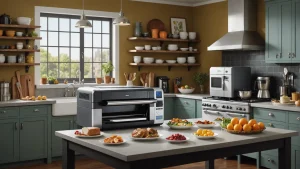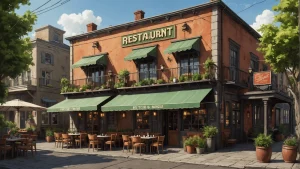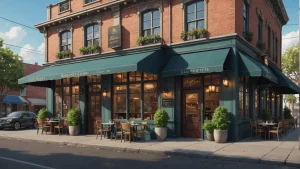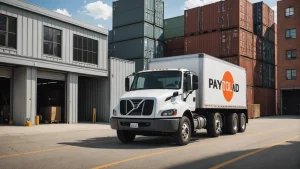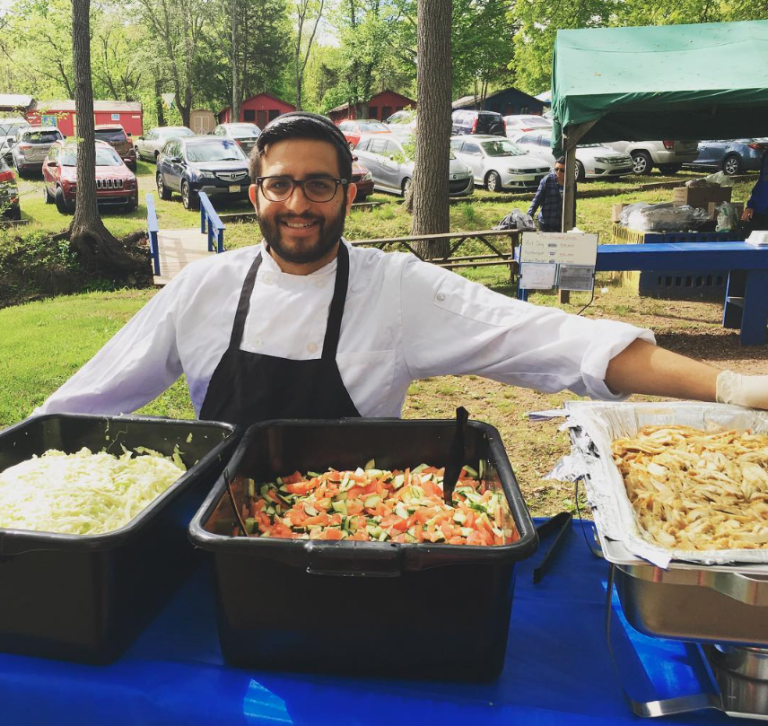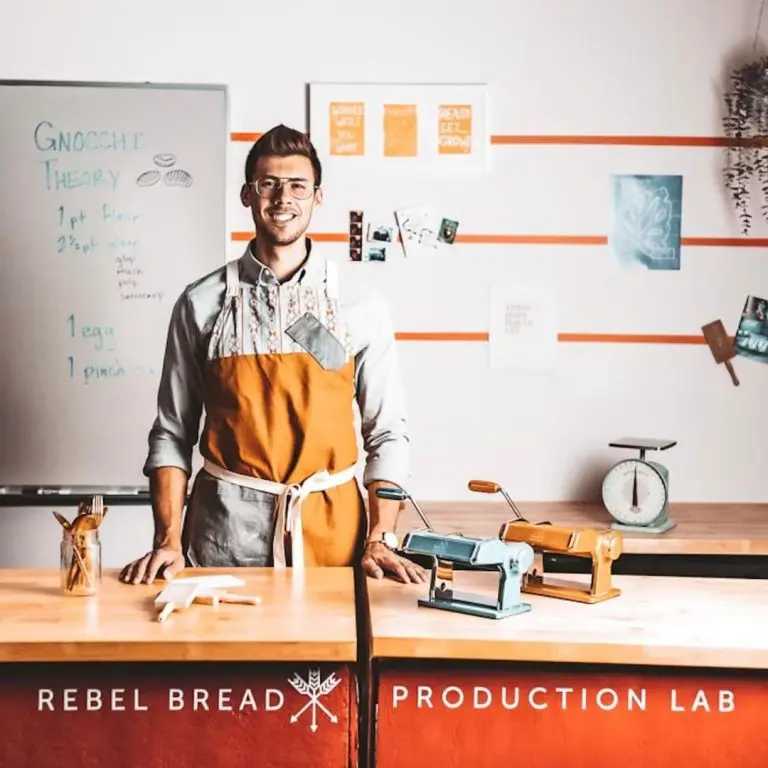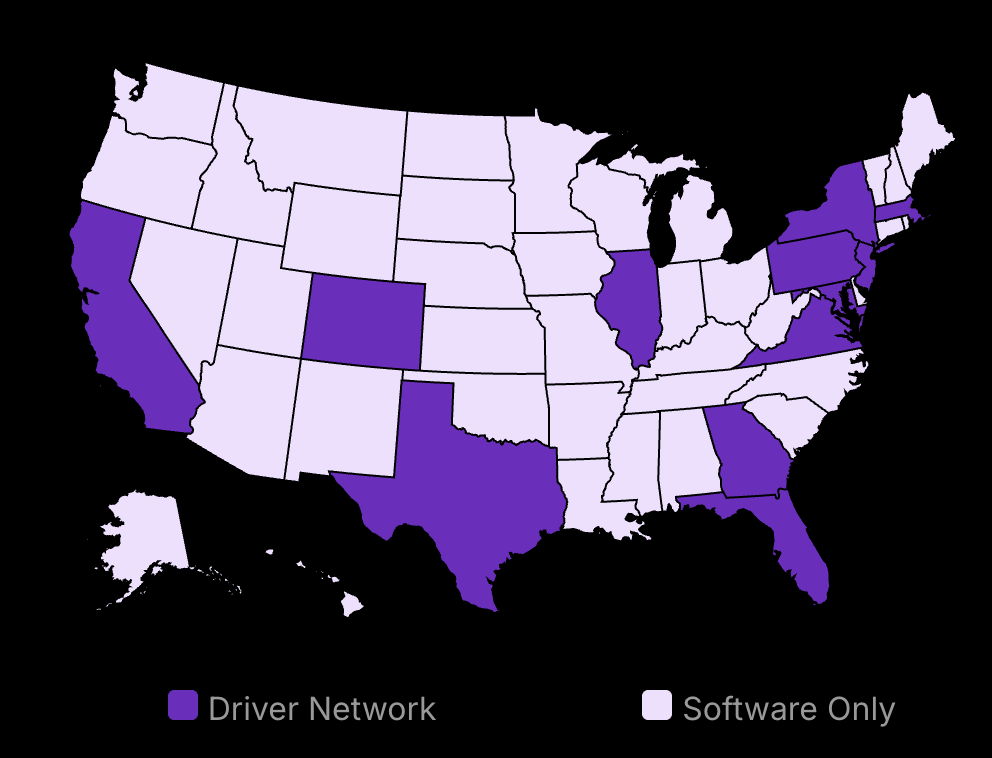Is your restaurant’s back-of-house a well-oiled machine or a ticking time bomb?
Behind the scenes, countless mistakes could be simmering, ready to boil over and burn your business. From poor inventory management to a disorganized kitchen layout, these blunders can quickly turn your dream restaurant into a nightmare.
But fear not! By identifying and addressing these common back-of-house mistakes, you can transform your restaurant’s behind-the-scenes operations into a recipe for success.
In this article, we’ll unveil the secrets to optimizing your back-of-house, ensuring your restaurant runs smoothly, efficiently, and profitably.

Metrobi drivers are rated 4.97 out of 5
Trusted by local businesses for:
- Background-checked professionals
- Specialized in business deliveries
- Same drivers for consistency
- 4.97/5 average delivery rating
What is a Restaurant Back of House?
The back of the house is the heart of a restaurant, where food preparation, inventory management, and essential functions take place.
Key areas include the kitchen, storage, and office, with staff such as the executive chef, line cooks, and dishwashers.
Understanding the back of the house is crucial for avoiding common mistakes and ensuring smooth restaurant operations.
The restaurant back of the house, often referred to as the “BOH,” encompasses all the areas and operations that customers don’t see directly. It’s where the magic happens behind the scenes, from food preparation and cooking to inventory management and administrative tasks. A well-organized and efficient back-of-house is crucial for delivering high-quality meals and exceptional dining experiences to customers.
Key Back of House Areas
The back of house consists of several critical areas and break rooms that work together to keep the restaurant running smoothly:
Kitchen
The kitchen is the centerpiece of the back of house dining area, where chefs and cooks prepare, cook, and plate dishes. It’s equipped with various cooking equipment, such as ovens, stoves, grills, and fryers, as well as prep stations for chopping, mixing, and assembling ingredients. The kitchen layout should be designed for efficiency, with a logical flow from food preparation to plating and serving the hot food.
Storage
Proper storage is essential for maintaining food quality, safety, and inventory control. The back of house includes separate storage areas for dry goods, refrigerated items, and cleaning supplies. Dry storage shelves should be organized and labeled, while refrigerators and freezers must maintain appropriate temperatures to prevent spoilage. Regular inventory checks help ensure that the restaurant has the necessary ingredients and supplies on hand.
Office
The back of house office is where administrative tasks take place, such as scheduling, ordering, and bookkeeping. It’s typically equipped with a computer, printer, and filing system for organizing important documents. The office is also where managers and supervisors can conduct meetings, review performance, and plan for upcoming events or menu changes.
Primary Back of House Staff
A skilled and dedicated back of house team is essential for a restaurant’s success. Here are the primary staff positions:
Executive Chef
The executive chef is the leader of the kitchen, responsible for overseeing all aspects of food preparation and presentation. They develop menus, create recipes line cook them, and ensure that dishes meet the restaurant’s quality standards. The executive chef also manages the kitchen staff, provides training, and maintains a safe and sanitary work environment.
Labor Shortage:
The restaurant industry has been struggling with a shortage of chefs and other back of house staff for several years. As of June 2021, the Bureau of Labor Statistics reported that the restaurant industry was still 1.5 million jobs – or 12% – short of pre-pandemic levels.
Line Cooks
Line cooks are responsible for preparing dishes according to recipes and standards set by the executive or sous chef. They work at various stations in the kitchen, such as the grill, sauté, or pastry stations. Line cooks must be skilled in cooking techniques, able to work efficiently under pressure, and maintain consistent quality across all dishes.
Dishwashers
Dishwashers play a vital role in maintaining the cleanliness and sanitation of the kitchen. They clean and sanitize dishes, utensils, and cooking equipment, ensuring the kitchen remains hygienic and compliant with health regulations. Dishwashers also assist with general cleaning tasks and may help with basic food preparation.
Understanding the key areas and staff positions in the restaurant’s back of the house is essential for identifying and addressing common mistakes. By optimizing back-of-house operations and fostering a skilled and collaborative team, restaurants can improve efficiency, reduce costs, and deliver exceptional dining experiences.

Metrobi is transforming catering deliveries
Specialized solutions for catering businesses:
- Catering-trained drivers
- Proper handling equipment
- Peak day delivery support
- 23% average cost reduction
Common Restaurant Back-of-House Mistakes and How to Avoid Them
Inefficient inventory management and kitchen layout can lead to food waste and increased costs
Lack of standardized recipes and procedures results in inconsistent food quality and customer experience
Neglecting equipment maintenance causes breakdowns, safety hazards, and decreased productivity
Mistake #1: Poor Inventory Management
Effective inventory management is crucial for the success of any restaurant. Failing to track inventory levels regularly can lead to overstocking or understocking ingredients, resulting in food waste and increased costs. Overstocking perishable items can cause spoilage, while understocking can lead to running out of key ingredients during service, causing customer dissatisfaction and lost sales. Want to enhance your restaurant’s inventory handling? Embrace these top strategies for managing restaurant inventory more efficiently to minimize waste and boost your bottom line.
To avoid these issues, implement an inventory management system that allows you to track inventory levels in real-time. This can be done using specialized software or even a well-organized spreadsheet. Regularly conduct physical inventory counts and compare them to your records to identify discrepancies and make necessary adjustments.
Consider using the First-In, First-Out (FIFO) method for inventory rotation, ensuring that older items are used before newer ones. This helps minimize waste and ensures the freshness of ingredients. Train your staff on proper inventory management procedures and emphasize the importance of accurate record-keeping.
Inventory Management:
A carefully maintained inventory spreadsheet can be an excellent tool to monitor stock levels, usage rates, and ordering schedules.
Inventory Management Tools and Software
Investing in inventory management tools and software can streamline the process and reduce errors. Some popular options include:
BinWise: A comprehensive inventory management system designed specifically for restaurants and bars
Toast Inventory: Integrates with the Toast POS system to provide real-time inventory tracking and reporting
Upserve Inventory: Offers features like recipe costing, vendor management, and automated ordering
Source AI: Provides auto-generated tweets and powerful automation to scale and engage your Twitter accounts
Restaurant365: A cloud-based restaurant management platform that includes inventory management, accounting, and scheduling features
Mistake #2: Inefficient Kitchen Layout
An inefficient kitchen layout can significantly hinder the productivity and efficiency of your back-of-house operations. Poorly organized workstations, inadequate space for staff to move around, and inconvenient placement of equipment and waiting areas can lead to slower service times, increased stress levels, and a higher risk of accidents.
To optimize your kitchen layout for a smooth workflow, start by analyzing your current setup and identifying bottlenecks or areas of congestion. Consider the flow of food preparation, from receiving ingredients to plating and serving. Ensure that workstations are organized logically, with frequently used items easily accessible.
Implement a kitchen zoning system, designating specific areas for different tasks such as food preparation, cooking, plating, and dishwashing. This helps minimize cross-contamination and reduces the risk of accidents. Provide ample space for staff to move around safely and efficiently, considering the number of employees working simultaneously during peak hours.
Kitchen Layout Best Practices
When designing or renovating your kitchen layout, keep these best practices in mind:
Create a linear flow from receiving to serving, minimizing backtracking and crossovers
Position frequently used equipment and ingredients within easy reach of relevant workstations
Ensure adequate ventilation and temperature control to maintain a comfortable working environment
Install non-slip flooring and proper lighting to reduce the risk of accidents
Consult with experienced kitchen designers or chefs to optimize your layout based on your specific needs
Mistake #3: Lack of Standardized Recipes and Procedures
Inconsistent food quality and presentation can be a major problem for restaurants, leading to customer dissatisfaction and negative reviews. When staff members are not provided with standardized recipes and procedures, confusion and inconsistencies arise, resulting in dishes that vary in taste, portion size, and appearance.
To ensure consistent food quality and presentation, create a set of standardized recipes and standard operating procedures (SOPs) for your back of house operations. Develop detailed recipes that specify ingredients, quantities, and preparation methods, leaving no room for interpretation. Include photos or illustrations to provide visual references for plating and presentation.
Implement SOPs for various tasks, such as food safety protocols, equipment usage, and cleaning procedures. Regularly train your staff on these standardized recipes and SOPs, ensuring that everyone follows the same guidelines. Conduct periodic quality checks to verify that dishes are being prepared and presented consistently.
Menu Updates:
31% of restaurateurs update their menu on a monthly basis.
Benefits of Standardized Recipes and Procedures
Implementing standardized recipes and procedures offers several benefits for your restaurant:
Consistent food quality and presentation, leading to higher customer satisfaction and loyalty
Improved efficiency and productivity, as staff members know exactly what to do and how to do it
Reduced food waste and costs, as portion sizes and preparation methods are standardized
Easier training and onboarding of new staff members, as they have clear guidelines to follow
Mistake #4: Neglecting Equipment Maintenance
Restaurant equipment is subjected to heavy use and wear, making regular maintenance and repairs essential for optimal performance and longevity. Neglecting equipment maintenance can lead to malfunctioning or broken equipment, resulting in decreased efficiency, increased safety risks, and costly repairs or replacements.
To avoid these issues, create a schedule for regular equipment maintenance and repairs. This should include daily, weekly, and monthly tasks such as cleaning, lubricating, and inspecting equipment. Assign specific responsibilities to staff members and provide them with the necessary training and tools to perform these tasks effectively.
Establish a system for reporting and addressing equipment issues promptly. Encourage staff to notify management of any signs of malfunction or wear, allowing for quick repairs before problems escalate. Keep a log of maintenance activities and repairs, as this can help identify patterns and plan for future maintenance needs.
Cost Savings:
Regular and efficient restaurant equipment maintenance results in approximately 50% lower overall spending compared to running a restaurant without regular equipment maintenance.Maintenance Costs:
The average preventative maintenance cost for a restaurant operator ranged from $516.22 for electrical repairs to $906.47 for plumbing repairs in 2020.Annual Maintenance Costs:
The average yearly spending on critical equipment repairs for quick service restaurants (QSRs) is $9,360 per location, including $520 per service incident on average
Preventive Maintenance Checklist
Develop a preventive maintenance checklist for your restaurant equipment, including items such as:
Daily cleaning and sanitizing of equipment surfaces
Weekly deep cleaning of equipment interior and exterior
Monthly inspection and lubrication of moving parts
Quarterly calibration and adjustment of temperature settings
Annual professional servicing and maintenance
Mistake #5: Inadequate Training and Communication
A well-trained and informed staff is essential for a smooth-running back of house operation. Inadequate training and communication can lead to confusion, mistakes, and a lack of teamwork, ultimately affecting the quality of food and service.
Invest in comprehensive training programs for your back of house staff such as a food runner or a chef, covering topics such as food safety, kitchen procedures, equipment usage, and communication protocols. Provide hands-on training and mentorship, allowing new staff members to learn from experienced team members. To truly elevate your team’s performance, it’s essential to focus on specialized training that enhances their ability to deliver excellent dining experiences. Discover proven methods and effective techniques in training staff for outstanding restaurant customer service, ensuring your patrons receive attentive and memorable care that keeps them coming back.
Encourage open communication and collaboration among back of house staff. Hold regular team meetings to discuss menu changes, service issues, and improvement opportunities. Foster a culture of continuous learning and growth, providing ongoing training and development opportunities for your staff.
Effective Communication Strategies
Implement effective communication strategies to ensure that information flows smoothly within your back of house team:
Use clear and concise language when communicating tasks and expectations
Establish a system for relaying information between shifts, such as a communication log or bulletin board
Encourage staff to ask questions and provide feedback, creating an environment of open dialogue
Utilize technology, such as messaging apps or digital displays, to streamline communication and keep everyone informed
By addressing these common back of house mistakes and implementing the suggested solutions, restaurants can improve efficiency, reduce costs, and enhance the overall quality of their food and service. A well-organized and well-trained back of house team is the foundation for a successful restaurant operation.
Benefits of an Efficient Restaurant Back of House
Improved Food Quality and Consistency
Standardized recipes are the backbone of a well-run restaurant kitchen. By meticulously documenting ingredients, portions, and preparation methods, chefs ensure that every dish leaving the kitchen meets the established quality standards. This consistency is crucial for building a loyal customer base who can rely on their favorite meals tasting the same every visit.
An efficient back of house layout and well-defined procedures minimize the risk of errors during the cooking process. When everything in grill cook, from ingredient storage to meal preparation follows a logical flow, kitchen staff can work more efficiently and accurately. This reduces the likelihood of undercooked, overcooked, or incorrectly assembled dishes reaching the customer’s table.
The Impact of Consistency on Customer Loyalty
Studies show that consistency is a key factor in building customer loyalty. A survey by Oracle found that 74% of customers are likely to return to a restaurant that provides consistent food quality and service.
Recommended reading: “The Consistency Principle: Why Success Demands Repetition” by Robert Stevenson delves into the importance of consistency across all aspects of business, including product quality and customer experience.
Enhanced Customer Satisfaction
An efficient back of house directly impacts the customer experience. When the kitchen runs like a well-oiled machine, orders are filled faster, and wait times are reduced. In today’s fast-paced world, customers appreciate quick service without compromising quality. An organized kitchen also minimizes waste, ensuring that food is utilized optimally and contributing significantly to the reduction of unnecessary food disposal.
Consistently delivering high-quality dishes also contributes to customer satisfaction. When patrons know they can count on a restaurant to meet their expectations every time, they’re more likely to become loyal customers and recommend the establishment to others.
Restaurant Technology:
73% of diners agree that restaurant technology improves their guest experience. 95% of restaurateurs agree that restaurant technology improves their business efficiency.
The Power of Word-of-Mouth Marketing
Satisfied customers are a restaurant’s best marketers. A study by Nielsen found that 92% of consumers trust recommendations from friends and family over all other forms of advertising.
Recommended reading: “Talk Triggers: The Complete Guide to Creating Customers with Word of Mouth” by Jay Baer and Daniel Lemin explores strategies for generating positive word-of-mouth marketing through exceptional customer experiences.
Increased Profitability
An efficient back of house can significantly boost a restaurant’s bottom line. By reducing food waste through proper inventory management and portion control, restaurants can minimize losses and ensure every ingredient is used to its fullest potential.
Streamlined operations also enable kitchen staff to work more productively, reducing labor costs. When tasks are optimized and everyone works efficiently, fewer staff hours are required to produce the same output.
Moreover, a well-run kitchen can handle a higher volume of orders, increasing overall sales. When the kitchen manager back of house can keep pace with customer demand, the restaurant can serve more patrons without compromising quality or service.
The Financial Impact of Food Waste
According to a study by the National Resources Defense Council, the average restaurant loses $1,000 per week due to food waste. Reducing waste by just 20% can save a restaurant $2,000 per month. Discover how a printer for the kitchen can aid in effectively managing food orders, thereby reducing waste and increasing savings for restaurants.
Waste Reduction Monthly Savings
10% $1,000
20% $2,000
30% $3,000
Recommended reading: “The Restaurant Manager’s Handbook: How to Set Up, Operate, and Manage a Financially Successful Food Service Operation” by Douglas Robert Brown offers practical advice on optimizing restaurant operations, including strategies for reducing waste and increasing profitability.
Food Waste Reduction:
28% of restaurants repurpose food trimmings, 26% offer varied portion sizes, and 25% compost to reduce food waste.
Improved Staff Morale and Retention
An efficient back of house not only benefits customers and the restaurant’s financial health but also contributes to a more positive work environment for staff. When the kitchen runs smoothly, and everyone knows their roles and responsibilities, there’s less stress and frustration among wait staff and team members.
In a well-organized kitchen or dining room, staff can focus on their tasks without constantly dealing with chaos or confusion. This leads to a greater sense of job satisfaction and pride in their work. Happy employees are more likely to stay with the restaurant long-term, reducing turnover and the associated costs of hiring and training new staff.
The Cost of Employee Turnover
Turnover Rates:
High restaurant turnover rates are common, with 25% of back of house restaurant workers having left the industry entirely. A study by the Center for Hospitality Research at Cornell University found that the average cost of replacing a single restaurant employee is $5,864. This includes direct costs like advertising and training, as well as indirect costs such as lost productivity.
Recommended reading: “The Heart of Hospitality: Great Hotel and Restaurant Leaders Share Their Secrets” by Micah Solomon emphasizes the importance of employee satisfaction and provides strategies for creating a positive work culture in the hospitality industry.
Competitive Advantage in the Market
Restaurants with efficient back of house operations have a distinct advantage over their competitors. By consistently delivering high-quality food and exceptional service, they can differentiate themselves in a crowded market.
As word spreads about a restaurant’s superior offerings and customer experience, it can attract new patrons and build a strong reputation. This, in turn, can lead to increased market share and long-term success.
The Importance of Differentiation
In a survey by Toast, 65% of restaurant owners cited increasing competition as a top challenge. Standing out in a saturated market requires a focus on quality, consistency, and customer satisfaction – all of which are supported by an efficient back of house.
Recommended reading: “The Innovator’s Dilemma: When New Technologies Cause Great Firms to Fail” by Clayton M. Christensen highlights the importance of adapting to change and differentiation in order to stay competitive in any industry, including the restaurant business.
Restaurant Back of House Best Practices
Implement Clear Communication Channels
Effective communication is the foundation of a well-functioning restaurant back of house. According to Chef Thomas Keller, “Communication is the most important thing in any kitchen. If you can’t communicate, you can’t cook”.
Regular staff meetings and training sessions are crucial for ensuring that everyone is on the same page. Use these opportunities to discuss menu changes, address any issues, and celebrate successes. As Chef Daniel Boulud notes, “The key to a successful kitchen is communication. Everyone needs to know what’s going on, from the dishwasher to the executive pastry chef.”.
Streamline Communication Between Front and Back of House
Effective communication between the front and back of house is essential for a smooth service. Implement systems like kitchen display screens or ticket printers to ensure that orders are accurately relayed to the kitchen. As restaurateur and house manager Danny Meyer explains, “The most important thing in a restaurant is that the guest feels taken care of, and that starts with communication between the front and back of house”.
Prioritize Cleanliness and Sanitation
Maintaining a clean and sanitary kitchen and dining room is not only a legal requirement but also essential for the efficiency and reputation of your restaurant. Adhere to all health department regulations and establish clear cleaning schedules and procedures.
As Chef Anthony Bourdain famously said, “I won’t eat in a restaurant with filthy bathrooms. This isn’t a hard call. They let you see the bathrooms. If the restaurant can’t be bothered to replace the puck in the urinal or keep the toilets and floors clean, then just imagine what their refrigeration and work spaces look like”.
Create a Culture of Cleanliness
Encourage all staff members to take responsibility for keeping the kitchen clean and organized. Implement a “clean as you go” policy and ensure that everyone understands the importance of proper sanitation. As Chef Gordon Ramsay puts it, “If you think the head chef is the most important person in the kitchen, you’re wrong. It’s the dishwasher. Without a clean environment, you can’t produce good food”.
Invest in Staff Training and Development
A well-trained and motivated staff is the backbone of a successful restaurant back of house. Provide ongoing training to improve skills, efficiency, and teamwork. Encourage cross-training so that team members can step in and assist when needed.
As Chef Eric Ripert notes, “The most important thing is to have a good team and make sure they are trained well and motivated. If you have a good team, you can do anything”.
Foster a Culture of Learning and Growth
Offer opportunities for staff to attend workshops, seminars, or conferences to expand their knowledge and skills. Encourage them to share what they’ve learned with the rest of the team. As Chef José Andrés says, “The best way to learn is by doing. In the kitchen, you learn by making mistakes and then not making them again”.
By implementing these best practices, you can create a restaurant back of house that is efficient, safe, and poised for success. As Chef Marcus Samuelsson puts it, “The kitchen is the heart of any restaurant, and if the heart isn’t functioning properly, the rest of the body will fail”.
How to Optimize Your Restaurant Back of House for Success
The back of house plays a crucial role in ensuring a restaurant’s success. From preparing high-quality, consistent dishes to managing inventory and minimizing waste, the back of house is responsible for maintaining a clean, safe, and efficient work environment that supports the front of house in delivering excellent customer service. Discover how the front of the restaurant is integral in creating unforgettable dining experiences by understanding its essential duties and required competencies.
Back-Office Technologies:
Accounting software (52%) and payroll software (50%) are the most popular back-office technologies used by restaurants.
Streamlining Processes and Workflows
One of the most effective ways to optimize your restaurant’s back of house is by streamlining processes and workflows. This involves identifying bottlenecks, eliminating unnecessary steps, and implementing standardized procedures that promote efficiency and consistency. Adopt optimal procedures in your restaurant’s operation to streamline your kitchen seamlessly, elevating your restaurant’s performance with unparalleled efficiency and productivity.
Implementing a Mise en Place System
A mise en place system is a French culinary term that translates to “everything in its place.” By organizing ingredients, tools, and equipment before service begins, back of house staff can work more efficiently and reduce the risk of errors or delays. This system also helps to minimize waste and ensure that dishes are prepared consistently every time. Explore the intricacies of managing a restaurant’s daily activities, from perfecting mise en place to ensuring the highest level of service. Delve into the foundational aspects of operational success in the culinary world.
Establishing Clear Communication Channels
Effective communication is essential for a well-functioning back of house. Establish clear communication channels between the kitchen, front of house employees, and management to ensure that everyone is on the same page. This can include regular team meetings, a centralized communication board, or digital communication tools like messaging apps or project management software.
Investing in Training and Development
Investing in the training and development of your back of house staff is another key strategy for optimizing performance. By providing ongoing education and skill-building opportunities, you can foster a culture of excellence and empower your team to deliver their best work.
Providing Culinary and Safety Training
Regular culinary and safety training can help back of house staff stay up-to-date on industry best practices, new techniques, and emerging trends. This can include in-house workshops, food runners, external courses, or certifications in areas like food safety, knife skills, or specialty cuisines.
Encouraging Cross-Training and Skill Sharing
Encouraging cross-training and skill sharing among back of house staff can increase flexibility, reduce burnout, and promote a more collaborative work environment. By training staff to perform multiple roles or tasks, you the general manager can ensure that your kitchen can adapt to changes in demand or staffing without compromising quality or efficiency.
Leveraging Technology to Enhance Operations
Technology can be a powerful tool for optimizing back of house operations. By leveraging digital tools and platforms, you can streamline communication, automate tasks, and gain valuable insights into your restaurant’s performance. Discover the essential features of restaurant management software to upgrade your establishment’s efficiency, enhance customer experience, and positively impact your revenue.
Implementing Inventory Management Software
Inventory management software can help you track food costs, minimize waste, and ensure that you always have the ingredients you need on hand. These tools can also generate reports and analytics that provide valuable insights into your restaurant’s purchasing patterns and profitability. Popular inventory management software solutions for restaurants include:
-
Toast Inventory Management
-
BevSpot
-
MarketMan
-
xtraCHEF
Using Digital Kitchen Display Systems
Digital kitchen display systems (KDS) can replace traditional paper tickets and improve communication between the front and back of house. These systems can automatically route orders to the appropriate stations, track ticket times, and provide real-time updates on order status. By digitizing the ordering process, KDS can reduce errors, increase efficiency, and enhance the overall guest dining experience throughout.
By focusing on these key areas and implementing best practices, you can elevate your restaurant’s back of house operations and achieve long-term success. Whether it’s streamlining workflows, investing in staff development, or leveraging technology, there are many strategies you can use to optimize your back of house and drive better results for your business.
Elevate Your Restaurant’s Success
Mastering your restaurant’s back of house operations is essential for delivering exceptional dining experiences. By avoiding common mistakes like poor inventory management, inefficient kitchen layouts, and lack of standardized procedures, you can ensure consistent food quality, faster service, and higher profitability.
Implementing best practices such as clear communication, prioritizing cleanliness, and investing in staff training will help you optimize your back of house for long-term success. Are you ready to take your restaurant’s operations to the next level? Another crucial factor that can significantly influence your restaurant’s profitability is optimizing the table turnover rate. Efficient back-of-house operations directly impact how swiftly orders are prepared and delivered, which in turn affects how quickly tables can be turned over. For insightful strategies on enhancing this key metric and maximizing your restaurant’s earnings, explore effective ways to improve your table turnover rate.







